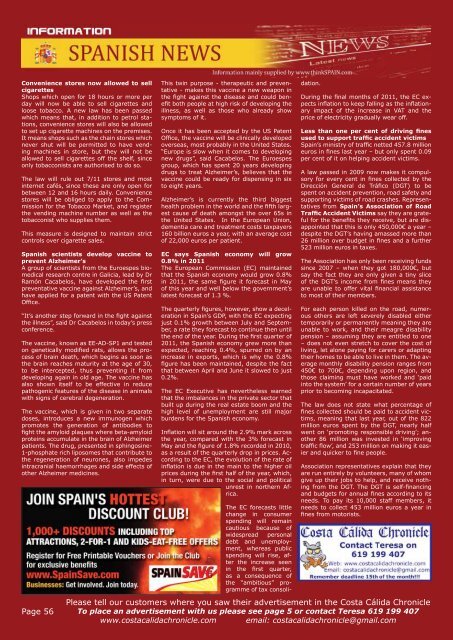October 2011 Issue - Costa Calida Chronicle
October 2011 Issue - Costa Calida Chronicle
October 2011 Issue - Costa Calida Chronicle
You also want an ePaper? Increase the reach of your titles
YUMPU automatically turns print PDFs into web optimized ePapers that Google loves.
In association with <strong>Costa</strong> Cálida International Radio and www.angloINFO.com<br />
Convenience stores now allowed to sell<br />
cigarettes<br />
Shops which open for 18 hours or more per<br />
day will now be able to sell cigarettes and<br />
loose tobacco. A new law has been passed<br />
which means that, in addition to petrol stations,<br />
convenience stores will also be allowed<br />
to set up cigarette machines on the premises.<br />
It means shops such as the chain stores which<br />
never shut will be permitted to have vending<br />
machines in store, but they will not be<br />
allowed to sell cigarettes off the shelf, since<br />
only tobacconists are authorised to do so.<br />
The law will rule out 7/11 stores and most<br />
internet cafés, since these are only open for<br />
between 12 and 16 hours daily. Convenience<br />
stores will be obliged to apply to the Commission<br />
for the Tobacco Market, and register<br />
the vending machine number as well as the<br />
tobacconist who supplies them.<br />
This measure is designed to maintain strict<br />
controls over cigarette sales.<br />
Spanish scientists develop vaccine to<br />
prevent Alzheimer’s<br />
A group of scientists from the Euroespes biomedical<br />
research centre in Galicia, lead by Dr<br />
Ramón Cacabelos, have developed the fi rst<br />
preventative vaccine against Alzheimer’s, and<br />
have applied for a patent with the US Patent<br />
Offi ce.<br />
“It’s another step forward in the fi ght against<br />
the illness”, said Dr Cacabelos in today’s press<br />
conference.<br />
The vaccine, known as EE-AD-SP1 and tested<br />
on genetically modifi ed rats, allows the process<br />
of brain death, which begins as soon as<br />
the brain reaches maturity at the age of 30,<br />
to be intercepted, thus preventing it from<br />
developing again in old age. The vaccine has<br />
also shown itself to be effective in reduce<br />
pathogenic features of the disease in animals<br />
with signs of cerebral degeneration.<br />
The vaccine, which is given in two separate<br />
doses, introduces a new immunogen which<br />
promotes the generation of antibodies to<br />
fi ght the amyloid plaques where beta-amyloid<br />
proteins accumulate in the brain of Alzheimer<br />
patients. The drug, presented in sphingosine-<br />
1-phosphate rich liposomes that contribute to<br />
the regeneration of neurones, also impedes<br />
intracranial haemorrhages and side effects of<br />
other Alzheimer medicines.<br />
Page 56<br />
This twin purpose - therapeutic and preventative<br />
- makes this vaccine a new weapon in<br />
the fi ght against the disease and could benefi<br />
t both people at high risk of developing the<br />
illness, as well as those who already show<br />
symptoms of it.<br />
Once it has been accepted by the US Patent<br />
Offi ce, the vaccine will be clinically developed<br />
overseas, most probably in the United States.<br />
“Europe is slow when it comes to developing<br />
new drugs”, said Cacabelos. The Euroespes<br />
group, which has spent 20 years developing<br />
drugs to treat Alzheimer’s, believes that the<br />
vaccine could be ready for dispensing in six<br />
to eight years.<br />
Alzheimer’s is currently the third biggest<br />
health problem in the world and the fi fth largest<br />
cause of death amongst the over 65s in<br />
the United States. In the European Union,<br />
dementia care and treatment costs taxpayers<br />
160 billion euros a year, with an average cost<br />
of 22,000 euros per patient.<br />
EC says Spanish economy will grow<br />
0.8% in <strong>2011</strong><br />
The European Commission (EC) maintained<br />
that the Spanish economy would grow 0.8%<br />
in <strong>2011</strong>, the same fi gure it forecast in May<br />
of this year and well below the government’s<br />
latest forecast of 1.3 %.<br />
The quarterly fi gures, however, show a deceleration<br />
in Spain’s GDP, with the EC expecting<br />
just 0.1% growth between July and September,<br />
a rate they forecast to continue then until<br />
the end of the year. During the fi rst quarter of<br />
<strong>2011</strong>, the Spanish economy grew more than<br />
expected, reaching 0.4%, spurred on by an<br />
increase in exports, which is why the 0.8%<br />
fi gure has been maintained, despite the fact<br />
that between April and June it slowed to just<br />
0.2%.<br />
The EC Executive has nevertheless warned<br />
that the imbalances in the private sector that<br />
built up during the real estate boom and the<br />
high level of unemployment are still major<br />
burdens for the Spanish economy.<br />
Infl ation will sit around the 2.9% mark across<br />
the year, compared with the 3% forecast in<br />
May and the fi gure of 1.8% recorded in 2010,<br />
as a result of the quarterly drop in prices. According<br />
to the EC, the evolution of the rate of<br />
infl ation is due in the main to the higher oil<br />
prices during the fi rst half of the year, which,<br />
in turn, were due to the social and political<br />
unrest in northern Africa.<br />
The EC forecasts little<br />
change in consumer<br />
spending will remain<br />
cautious because of<br />
widespread personal<br />
debt and unemployment,<br />
whereas public<br />
spending will rise, after<br />
the increase seen<br />
in the fi rst quarter,<br />
as a consequence of<br />
the “ambitious” programme<br />
of tax consoli-<br />
dation.<br />
During the fi nal months of <strong>2011</strong>, the EC expects<br />
infl ation to keep falling as the infl ationary<br />
impact of the increase in VAT and the<br />
price of electricity gradually wear off.<br />
Less than one per cent of driving fi nes<br />
used to support traffi c accident victims<br />
Spain’s ministry of traffi c netted 457.8 million<br />
euros in fi nes last year – but only spent 0.09<br />
per cent of it on helping accident victims.<br />
A law passed in 2009 now makes it compulsory<br />
for every cent in fi nes collected by the<br />
Dirección General de Tráfi co (DGT) to be<br />
spent on accident prevention, road safety and<br />
supporting victims of road crashes. Representatives<br />
from Spain’s Association of Road<br />
Traffi c Accident Victims say they are grateful<br />
for the benefi ts they receive, but are disappointed<br />
that this is only 450,000€ a year –<br />
despite the DGT’s having amassed more than<br />
26 million over budget in fi nes and a further<br />
523 million euros in taxes.<br />
The Association has only been receiving funds<br />
since 2007 – when they got 180,000€, but<br />
say the fact they are only given a tiny slice<br />
of the DGT’s income from fi nes means they<br />
are unable to offer vital fi nancial assistance<br />
to most of their members.<br />
For each person killed on the road, numerous<br />
others are left severely disabled either<br />
temporarily or permanently meaning they are<br />
unable to work, and their meagre disability<br />
pension – assuming they are entitled to one<br />
– does not even stretch to cover the cost of<br />
living, let alone paying for carers or adapting<br />
their homes to be able to live in them. The average<br />
monthly disability pension ranges from<br />
450€ to 700€, depending upon region, and<br />
those claiming must have worked and ‘paid<br />
into the system’ for a certain number of years<br />
prior to becoming incapacitated.<br />
The law does not state what percentage of<br />
fi nes collected should be paid to accident victims,<br />
meaning that last year, out of the 822<br />
million euros spent by the DGT, nearly half<br />
went on ‘promoting responsible driving’; another<br />
86 million was invested in ‘improving<br />
traffi c fl ow’, and 253 million on making it easier<br />
and quicker to fi ne people.<br />
Association representatives explain that they<br />
are run entirely by volunteers, many of whom<br />
give up their jobs to help, and receive nothing<br />
from the DGT. The DGT is self-fi nancing<br />
and budgets for annual fi nes according to its<br />
needs. To pay its 10,000 staff members, it<br />
needs to collect 453 million euros a year in<br />
fi nes from motorists.<br />
Please tell our customers where you saw their advertisement in the <strong>Costa</strong> Cálida <strong>Chronicle</strong><br />
To place an advertisement with us please see page 5 or contact Teresa 619 199 407<br />
www.costacalidachronicle.com email: costacalidachronicle@gmail.com
















